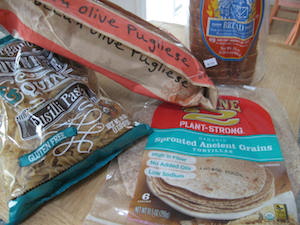Gluten-free has become a trendy buzzword among the health conscious. But is it right for everyone, even if you aren’t experiencing symptoms of having a gluten sensitivity?
What is gluten?
Gluten is a protein that naturally exists in wheat, rye, and barley and can be found in a variety of processed foods, including salad dressings and seasoning mixes. Gluten is also hiding in some vitamins, medications and makeup products. Gluten’s main claim to fame is its ability to help foods maintain its shape. That’s why it’s an essential part of baking. When combined with water, gluten’s strong, sticky protein gives structure to baked goods and pastas.
Gluten has become a popular meat substitute for vegans and vegetarians. High in protein, a four-ounce serving of seitan (a processed gluten meat substitute) contains about 26 grams of protein. Gluten is also low in fat and high in iron.(1)
When is gluten bad?
Gluten is harmful to people with celiac disease or a gluten sensitivity. When people with celiac disease (an autoimmune disorder) eat gluten it triggers an allergic reaction that results in inflammation and destruction to the lining of their small intestine and the malabsorption of nutrients. People with celiac disease tend to experience varying degrees of gastrointestinal issues, joint pain and skin rashes. In addition, studies have shown a link between celiac disease and neurological symptoms such as anxiety, depression, autism, epilepsy, and schizophrenia.(2) And there is strong evidence that individuals with autism, epilepsy, and schizophrenia all respond well to a gluten-free diet.(3) It only takes a very small amount of gluten (about 50 milligrams) to cause intestinal damage for a person with celiac disease. Learn more.
A related condition called gluten sensitivity or non-celiac gluten sensitivity can cause symptoms similar to celiac disease with an increase in the non-GI symptoms such as headaches, joint pain and numbness in the limbs and fingers. Individuals with gluten sensitivity lack the same antibodies as those with celiac disease and do not experience the same intestinal damage. Where celiac disease is considered an autoimmune disease, gluten sensitivity is an innate immune response where the immune system’s response does not target your own body’s tissues.
What to do if you think you have a gluten issue
A simple blood test looking for the presence of antibodies against a protein called transglutaminase can determine if you have celiac disease; a biopsy of the intestine is used to confirm the diagnosis.(4)
If you think you have a gluten sensitivity, you may want to try an elimination diet. By eliminating gluten from your diet for two to six weeks and paying attention to how your body responds, you can determine if gluten is an issue for you. If your symptoms disappear, you likely have a gluten sensitivity. To verify the results, reintroduce gluten to your diet systematically and pay attention to how your body responds. Because gluten is hidden in so many products, it may be difficult at first to completely eliminate it from your diet. You’ll need to read your food labels carefully.
Other things to consider when eating wheat products
Wheat encourages acidosis. Wheat is very acidic and when consumed it disrupts the pH balance necessary for optimal health. Learn more about balancing your pH.
Refined wheat products are stripped of their natural nutrients. The Western American Diet is high it refined wheat products (crackers, breakfast cereals, conventional pastas, pastries). A high carbohydrate-low nutrient diet negatively impacts your health, resulting in nutrient deficiencies. To obtain optimal health, it is important to consume nutrient dense whole plant-based foods, limiting refined products that fill you up with empty calories.
Most commercial breads contain processed sugar and other additives. Read your labels carefully and learn about the negative effects of processed sugars to your health.
Eating a diet high in grains, including wheat, can cause malabsoption of the essential minerals calcium, iron and zinc. Most grains contain phytic acid, a molecule that prevents the absorption of calcium, iron and zinc when consumed.(5) Soaking grains prior to cooking degrades the phytic acid and improves the bioavailability of the nutrients. If I am cooking grains for dinner, I begin soaking them in the morning and then cook them at dinner time.
To be or not to be gluten-free
According to the National Foundation for Celiac Awareness, in 2010, gluten-free sales reached more than $2.6 billion, about 1% of the population has celiac disease and that 83% of Americans who have celiac disease are undiagnosed or misdiagnosed with other condition. If you have celiac disease or a diagnosed gluten sensitivity, staying away from all gluten has been proven to be critical for your health. However, today, there are very few studies on the effect of consuming wheat on healthy individuals who do not have gluten issues, leaving those in good health wondering what to do.
What do I believe? Moderation is key. Here are some suggestions:
- Center your diet around whole nutrient dense foods (fresh fruits, vegetables and whole grains). Limit your consumption of wheat products to occasional eating and balance your diet by including more whole natural nutrient dense foods. If you choose to completely eliminate gluten from your diet, it is also important to remember to incorporate other foods that provide the nutrition you are no longer consuming.
- Gluten-free products are not always healthier. According to a report from the American Dietetic Association in 2005, gluten-free products tend to be low in a wide range of important nutrients, such as B vitamins, calcium, iron, zinc, magnesium, and fiber. Read the labels careful when purchasing gluten-free products. Also, watch out for added sugars, GMO corn, preservatives, and saturated fat that tend to be used as wheat replacers. Learn more.
- Experiment with other grains and flours. Amaranth, brown rice, buckwheat, millet, oats, quinoa and wild rice are all naturally gluten-free and nutrient rich. You can find these grains and flours in the bulk bins of most health food stores or in the health food section of the larger grocery stores. These grains can be used to create delicious breakfast cereals and side dishes. When ground into flour, millet, oats, quinoa, brown rice can be used to create wonderful baked desserts and breads. Bean flours are also growing in popularity. Experiment using garbanzo or fava flour. You can even combine different grains in your flour mixes, and/or add nut or seed meals made from almonds, pecans, and sunflower seeds to create a more complex nutty flavor when baking.
- Try one of our gluten-free recipes:


Love seeing more people spread the word about phytic acid! It’s crazy how that stuff works, and how little most people know about it!